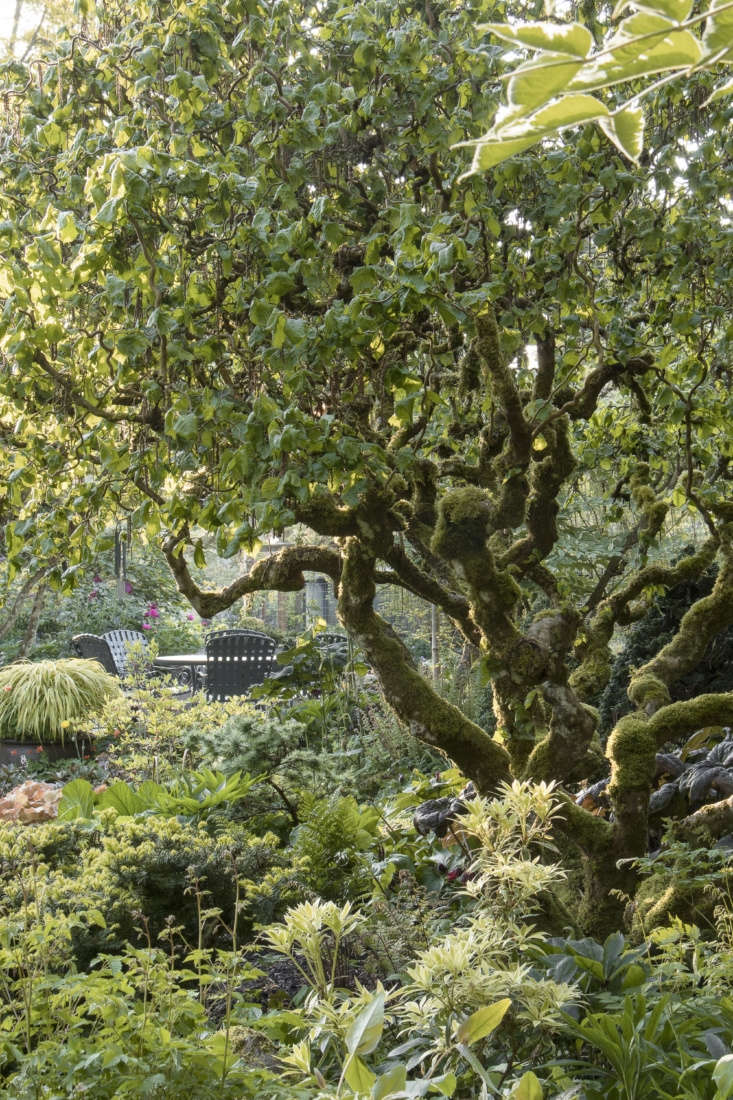My mother’s grandmother, Nettie Bailey of Dividing Creek, New Jersey, died when I was a very young child. My memories of her are sketchy and few. They mainly consist of a few vague images of a visit my parents and I made to her tiny rural cabin where she lived alone, and apparently quite happily, without indoor plumbing or electricity until she was well into her nineties. She is still, however, vividly alive to me because I own a small coverlet she made for me. It is a miniature crazy quilt composed of brightly colored scraps of fabric that she put together by hand. The scraps are a hodgepodge of many colors and textures. Taken individually they don’t seem to harmonize but Nettie was not only skilled with a needle, she had an artist’s eye and the elements of the quilt are quite pleasing together.
My great grandmother’s talent came to mind recently when I was reading A Tapestry Garden: The Art of Weaving Plants and Place by Marietta and Ernie O’Byrne ($24.67 on Amazon). This is the fascinating story of a tireless and simpatico couple, a pair of gardeners who have spent more than 40 years assembling a mind-boggling collection of plants and installing them in unexpected, sometimes truly revolutionary, combinations. Their one and a half acre garden in Eugene, Oregon, is an over-the-top creation where several types of landscapes have been re-created, tweaked, stuffed to bursting with plants, and woven together into a crazy quilt of surprising yet compatible styles.
Photography by Doreen Wynja, unless otherwise noted.

Although both the O’Byrnes are credited as writers of this book, we seem to be seeing the garden from Marietta’s point of view. In an early chapter on their shade garden, Marietta alludes to their distinctive style of placing plants tightly together, “In our garden every inch counts. This gardener abhors a vacuum [bare soil].”

Indeed it seems that the O’Byrnes anticipated the current landscape design trend of eschewing mulch for plants. Open space under a shrub? Get out the trowel and install a ground cover or two. Marietta and Ernie were doing it long before today’s forward-thinking designers such as Thomas Rainer and Claudia West began writing books such as Planting in a Post-Wild World, advising us to discard the idea of the solitary specimen plant and design our gardens in layers to mimic native landscapes.
In a chatty style, Marietta takes us through the garden’s various areas: shade garden, woods, shady border, chaparral, rock garden, heath, vegetable garden, and perennial borders. There are plenty of details about the evolution of the property, which she purchased with her first husband in 1972 as a 70-acre farm with a ramshackle circa 1918 farmhouse.

Over the years the garden has been painstakingly carved out of the meadows, derelict orchards, and forest of the original homestead. We learn about false starts and mistakes, plants that didn’t make it, trees that succumbed to natural disasters and other whims of Mother Nature. Marietta is quick to acknowledge a certain hard-hearted attitude about plants that disappoint: “I realize now that perfection can never be achieved, and plants can be pruned, moved, or even discarded to the compost heap with the help of a wheelbarrow.”
Interspersed among the chapters about the garden’s diverse landscapes are informative sections on specific plants such as Arisaemas; trilliums; bulbs, corms, tubers, and rhizomes; and hellebores.

The section on hellebores is particularly interesting. The O’Byrnes were running a landscaping business when they began their garden. Wishing to spend more time working on their own property instead of in the gardens of others, they opened a nursery to sell unusual plants. In time the business grew into a specialized wholesale operation for the breeding and limited selling of hellebores. The chapter on this plant is filled with details on how hybrid crosses are made, best practices of care and vivid descriptions of rare varieties.
Throughout the book we are offered useful tidbits and advice. In discussing shade gardening, for instance, we are told that seabird guano is a favored fertilizer and that plants with silver-colored leaves “glow more silvery in deep shade.”

The book concludes with “Caring for the Garden,” a chapter on how the O’Byrnes manage the intensive care they give their creation. But even after you know that they employ a small staff and make use of machines, such as leaf blowers and wood chippers, their dedication and energy are still mightily impressive.

Summing up the extraordinary amount of work expended over the years, Marietta is remarkably cheery and philosophical. Going through some old photos of the garden, she is inspired to muse, “Gardening is not like painting a picture. When a painting is finished, it stays as is, but a garden canvas gets repainted with every growing season.”

- Landscaping 101: Pleached Trees
- Architects’ Secrets: 10 Ideas to Create Privacy in the Garden
- An Urban Outdoor Shower (Privacy Included)









Have a Question or Comment About This Post?
Join the conversation